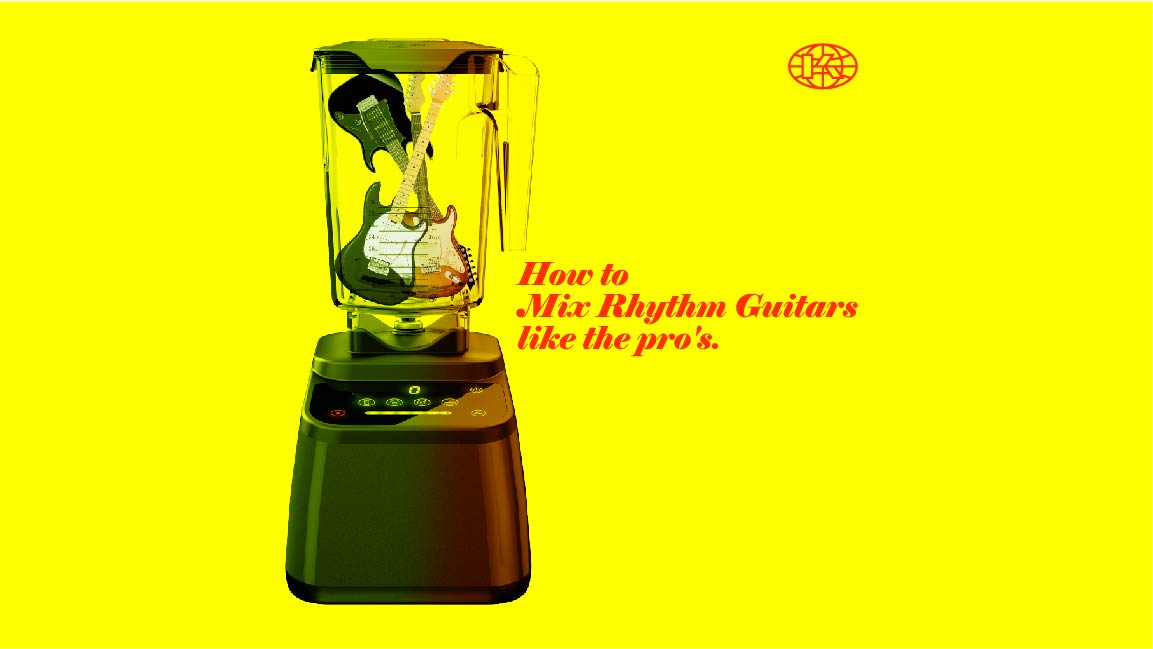
When it comes to mixing rhythm guitars, especially those with overdrive or distortion using amp simulator plugins, there are some things to consider and problems to avoid. Rhythm guitars could push the overall energy of the mix, but it also could overtake the whole frequency spectrum and make everything muddy. The frequency of guitars could clash with vocals, and also with the bass guitar. Leaving us with messy sounding production.
Keep in mind, we choose our amps, cabinets, and speakers before anything else. We are looking for the best guitar tone that serves the song and works great with the rest of the instruments. Doing this will leave us with fewer problems later trying to fix fundamental things with drastic EQ changes. Trying to make a guitar sounding great with EQ or any other tools after being recorded will make it sounds unnatural and might create other problems.
How do we fix that?
- Clear the low end and give space for the bass
- Use different cabinets, microphones, and/or pickup position
- Use subtractive EQ.
- Use different EQ settings on your amp
- Add presence around 3khz on one of the tracks.
- Put the guitars on a bus track and use a slight compression to control the energy during the palm-muted chords
- Use a multiband compressor Plugin and compress around 150 – 250 Hz
- Use a reverb Plugin on the guitar bus to put them back in the mix and add depth.
Interaction between the bass guitar and rhythm guitars
The interaction between the bass guitar and rhythm guitars is commonly neglected. Having that big low-end power on the song is a combination between the bass guitar fundamental frequencies and the guitar’s lower mid-range. Most of the time, it’s good to cut around 100hz using a high pass filter on the guitars and boost the bass guitar around 60 – 80 Hz.
Record different takes with different mic and cabinet
Tracking with different speaker cabinets or microphones on our rhythm guitars is the best way to separate guitar layers over layers. When we pan them hard left and right they will sound much wider and also have that 3D feeling. For example; when using Amplifikation Caliburn, you can use Lead British cab on a track and use Classic British on the other channel.
Subtractive EQ
Subtractive EQ is an equalization technique where you cut frequencies instead of boost
Search around 250 Hz for resonance frequencies produced by the speaker cabinet. Usually happens from the construction and how big the speaker enclosure is. You can cut 250 Hz on the left channel, boost a little at 350 Hz to not lose the body. Do the opposite on the other channel.
Use different tone at the amp EQ settings
Dial-in different tones by adjusting the amp settings. A slight variation in the middle will bring even more separation. The minor discrepancy between the gain and the master volume will make it sound tighter.
Adding presence
Looking for some presence in the mix and want to bring up the guitar level? Before you push the fader, add a few dB boosts around 2-3 kHz. Keep in mind it depends on the guitar tone that you are looking for. You can sweep around and find the best spot. Don’t make it too sharp. Just make it pop out. Make the second channel different Boost it at 4 kHz.
Use a bus track to glue them up
Make a bus track in your DAW and route the guitar tracks through it. Add a compressor and make it compress about 1-2 dB reduction to control the dynamic and glue the guitars up.
Multiband compressor to control the low end
Add a multiband compressor and use just a single band and choose your compression frequency around 150-250 Hz. Pull the threshold down until it starts compressing and catching only the palm-muted notes. This will keep them from overpowering the mix and will clean it further.
Add reverb for depth
Add a reverb on a bus track and send your guitar channel into it. Using reverb in overdriven guitars or guitar with heavy distortion is actually pretty common. In reality, every musical instrument recorded in a studio exists in an environment with reflective surfaces and this produces different reverberations.
Additional note: Modern productions, especially the metal genres, are aiming for a really dry and tight rhythm section, so using an isolation box with a speaker inside and microphones is often used to minimize the reflection in the studio room.
In our case we will add a little room reverb to bring back some life, taking in an account we are using almost dry sounding speakers and cabinet emulation in our amp simulator.
Usually, this always helps the overall sound of the mix and blend things together.
Final words
Mixing should be always fun and it’s one of the final touching steps that will help a great sounding track to become an art. Too much fiddling with EQs and post-processing could kill the mix. But with a balance between great source, careful carving, and tone shaping, it could also make things sound great.

